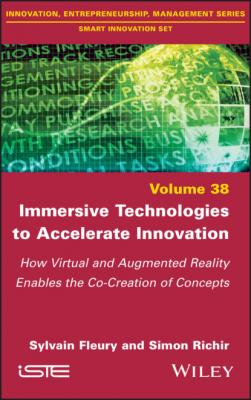Immersive Technologies to Accelerate Innovation. Simon Richir
Читать онлайн.| Название | Immersive Technologies to Accelerate Innovation |
|---|---|
| Автор произведения | Simon Richir |
| Жанр | Экономика |
| Серия | |
| Издательство | Экономика |
| Год выпуска | 0 |
| isbn | 9781119887287 |
1.1.5. Modeling innovation at the company level
Numerous models exist which outline the innovation process, that is, the stages located before the industrialization of a product, which we will call the upstream phases of design. Several of these models take the form of a funnel, wide on the left and thin on the right, to graphically represent a large number of ideas at the beginning and successive selection stages as concepts are developed. This is the case, for example, with the innovation funnel
Bouchard et al. (2006) have modeled product design in the context of work on innovation in the automotive sector. This approach concerns a process in which the designer’s creativity will potentially concern innovative uses or functions, but also esthetic choices. This innovation process is composed of three main successive steps: inspiration, generation and embodiment. Inspiration corresponds to the exploration process which consists of gathering data concerning the context of the future product in order to converge on first guidelines. This can take the form of a moodboard
1.2. The blue ocean strategy
The traditional approach is to face a known market in which companies compete violently for market share against each other on a roughly constant demand. This is the red ocean strategy. The ocean is red with the blood generated by this violence. It is also red with the color of the companies’ accounts. In this red ocean, decisions are made based on the competition. The advantage is that you know the market; you know it exists and you know its main characteristics. So it is a question of exploiting the existing demand, of beating the competitors, either by obtaining a better quality-price ratio or by differentiating oneself.
The blue ocean strategy described in the book Blue Ocean Strategy (Mauborgne and Kim 2007) is about moving away from an obsession with confrontation and instead seeking to create virgin markets. It is about creating trends rather than adapting to established trends. In the blue ocean, the company is not caught in competitive wars because it is the only one there. The new market does not necessarily require a technological innovation; it can be a service innovation as long as it creates value for both the company and the buyer. These innovations that create both profitability for the company and usefulness for the customer are called “useful” innovations. The blue oceans are therefore made up of all the activities in which there is not yet a competitive confrontation because they have not yet been developed, or because only one player has positioned itself there. In the blue oceans, there are many opportunities for strong and rapid growth. Logically, each blue ocean discovered by an innovative company ends up becoming a red ocean because of the arrival of competitors with an imitation strategy.
The creation of a blue ocean market should not be confused with technological innovation. Technological innovation is certainly a factor in the development of markets, but it is not necessarily the central determinant of the appearance of a new market. It is easy to find many examples of companies that have created new markets without technological innovation being the driving force:
– Starbucks, for example, corresponds only to a new use;
– Uber is technologically only a mobile application.
Conversely, a truly technologically innovative product may not open up a new market if it is not acceptable, useful, fun or easy to use. Google Glasses1
The companies that manage to go into a blue ocean are those that are successful in creating value by innovating. This value creation can come from a simplification of something that already exists, from a gain in time, productivity, pleasure, meaning, etc. In any case, technological innovation is only one way to open a market.
The blue ocean strategy should not be confused with differentiation. Differentiation consists mainly of making trade-offs on cost and service. Overall, it is about doing the same thing as a competitor, but cheaper or more high-end. Of course, when we create a low-cost
1.3. Open innovation
Open innovation is an innovation management technique theorized in the early 2000s by Henry Chesbrough, a research professor at the University of Berkley. He did not invent this approach, but grouped under the name “open innovation” practices that he saw emerging in more and more companies. This is a mode of organization in which people outside the R&D department and possibly outside the company take part directly in the innovation process. This type of approach can be in tension with the widespread culture of secrecy in the field of innovation, since each company wants to avoid its competitors being able to anticipate or copy the innovations it is going to produce. Practicing open innovation therefore requires dealing with intellectual property issues upstream and with rigor.
1.3.1. The two types of open innovation
We classically identify two main categories of open innovation: inside-out and outside-in (Chesbrough 2003). Inside-out open innovation starts with a desire to apply a company’s technology to other markets in order to increase the return on investment or to anticipate a change in the market. For a large company, it is a matter of putting in place a small team to develop an area that does not fit into the global strategy. Extracting a team through a business creation allows us to benefit from the agility of a small company to find a new market. The best known example of inside-out
Outside-in open innovation
